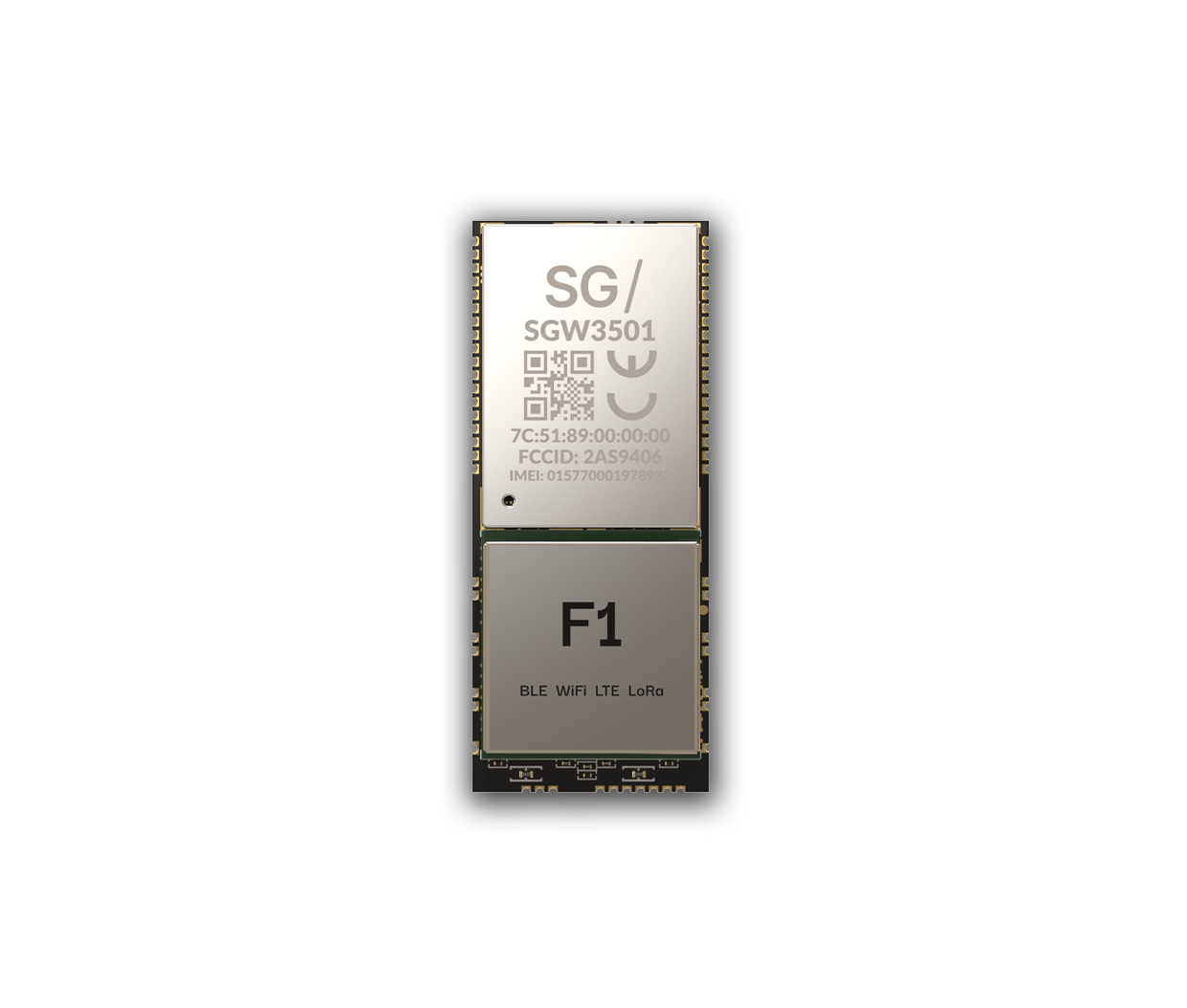Your basket is currently empty!
F1 Smart Module

One module,
four connectivity protocols.
The F1 Smart Module is a production-ready platform that delivers LTE Cat-M1/NB-IoT, LoRaWAN, Wi-Fi, and Bluetooth LE connectivity in one compact form factor. Pre-certified and programmable with MicroPython, it’s built for rapid deployment and real-world scale.
With unified APIs, technical documentation, and code examples, the F1 Smart Module cuts development time and complexity. The no-nonsense choice for developers who demand reliable, multi-protocol IoT hardware that just works.
Also available in the cellular-only F1/C Cellular Module or the LoRa-only F1/L LoRa Module.
Key Features
🌐 4-Protocol Powerhouse
- Uniquely integrates BLE, Wi-Fi, LTE and LoRa in one compact module.
- Operates across short-range, local, wide-area, and cellular networks with unmatched flexibility for diverse IoT applications.
- The F1 delivers complete connectivity coverage in a single integration rather than protocol subsets.
- Uniquely integrates BLE, Wi-Fi, LTE and LoRa in one compact module.
- Operates across short-range, local, wide-area, and cellular networks with unmatched flexibility for diverse IoT applications.
- The F1 delivers complete connectivity coverage in a single integration rather than protocol subsets.
🐍 MicroPython REPL Ready
- Interactive development via Read-Eval-Print Loop shell for immediate results, real-time debugging, and rapid prototyping.
- VS Code plugin CtrlR provides streamlined development and debugging workflows.
- Compared to complex C/C++ SDKs, this allows faster iteration cycles and easier team collaboration.
- Interactive development via Read-Eval-Print Loop shell for immediate results, real-time debugging, and rapid prototyping.
- VS Code plugin CtrlR provides streamlined development and debugging workflows.
- Compared to complex C/C++ SDKs, this allows faster iteration cycles and easier team collaboration.
⚡Powerful Processing Core
- Runs on Xtensa® Dual-core 32-bit LX7 Microprocessor at up to 240MHz with substantial memory resources.
- A robust processing foundation that can handle complex IoT applications, concurrent protocol management, and intensive data processing tasks that require both computational power and ample memory allocation.
- Runs on Xtensa® Dual-core 32-bit LX7 Microprocessor at up to 240MHz with substantial memory resources.
- A robust processing foundation that can handle complex IoT applications, concurrent protocol management, and intensive data processing tasks that require both computational power and ample memory allocation.
🔋Ultra-low Power
- Maximizes operational lifespan of battery-powered IoT devices and minimizes energy costs in long-term deployments with only 10µA deep sleep current.
- Critical for applications requiring years of autonomous operation without battery replacement or frequent maintenance cycles.
- Maximizes operational lifespan of battery-powered IoT devices and minimizes energy costs in long-term deployments with only 10µA deep sleep current.
- Critical for applications requiring years of autonomous operation without battery replacement or frequent maintenance cycles.
Specifications
Processor
- Xtensa dual-core 32-bit LX7, 240MHz
- 384KB ROM, 512KB SRAM, 8MB PSRAM, 16MB Flash
- Deep Sleep: 10μA current consumption
Form Factor
- Dimensions: 42.6mm x 17.6mm
- 27 pins available
- Operating Temp: -40°C to 85°C
- Power: 3.3V (ESP32-S3), 5V (LTE module)
Connectivity
- Wi-Fi: 802.11b/g/n (2.4GHz), up to 54Mbps, 20dBm Tx power
- Bluetooth LE: 5.0, 125kbps – 2Mbps, 20dBm Tx power
- LTE: Cat-M1/NB1/NB2, +23dBm Tx power (Sequans Monarch2)
- LoRa: 868/915MHz, +22dBm Tx, -127dBm sensitivity (Semtech SX1262)
Built on Pycom Legacy,
Designed for the Future
We acquired Pycom’s assets and technology foundation,
making the F1 Smart Module the direct successor to EOL Pycom products.
Built on the same core technologies,
the F1 preserves what made Pycom great while improving what held it back.
Same MicroPython development experience, same multi-protocol capabilities,
but with enterprise-grade reliability and long-term support.
Same Technical DNA
The F1 preserves what made Pycom great:
- ESP32 Architecture: Same dual-core foundation, upgraded to ESP32-S3 with 240MHz processing.
- MicroPython Environment: Familiar REPL-based development with interactive debugging.
- Multi-Protocol Integration: Wi-Fi, Bluetooth LE, LoRa, and LTE connectivity in one module.
- Compact Form Factor: Pin-compatible approach with enhanced I/O accessibility (27 pins vs. typical 22-28).
.
.
What We Improved
Pycom had solid hardware but operational issues that couldn’t sustain ongoing projects:
- EOL Uncertainty: The F1 has active development roadmap and long-term support commitment.
- Limited Cellular Coverage: Complete LTE Cat-M1/NB1/NB2 support across all variants, not just select models.
- Community-Only Tooling: Our VS Code plugin CtrlR opens up development workflows beyond traditional community-driven tools
- Manual Provisioning: Zero-touch deployment eliminates field configuration errors and delays.
.
.
Your Upgrade Path
A natural evolution of Pycom technology, the F1 maintains ecosystem continuity while delivering modern enhancements:
- Code Compatibility: Your existing MicroPython code runs on F1 with minimal modifications. Same API structure, same development workflow.
- Hardware Integration: 27 I/O connections support existing PCB designs. Arduino ecosystem compatibility through our F1 Starter Kit eliminates redesign work.
- Fully Certified: FCC- and CE-certified, with flexibility for other certification needs.
- Enhanced Development Tools: VS Code plugin CtrlR streamlines the development environment the Pycom community wanted, plus enterprise-grade cloud integration through Ctrl Cloud platform.